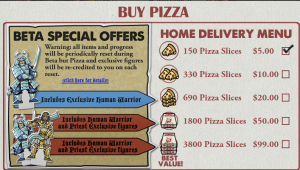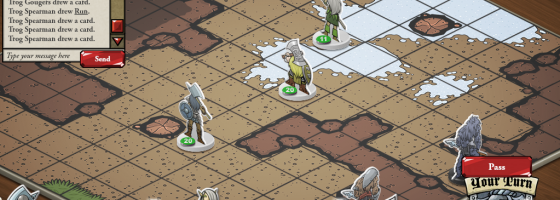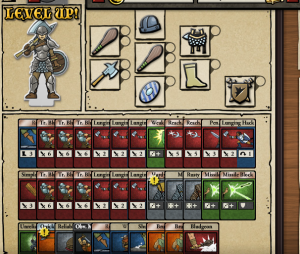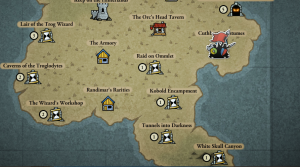Collectible Card Game or CCG design is one of my favorite concepts that we don’t see too much outside of the respective genre. The ability to personalize your strategy from a variety of tactics is great. With Card Hunter, we may have one of the most dangerous threats to your free time: A browser-based CCG tactical RPG.
PNP+CCG=…:
Card Hunter is currently in beta from Blue Manchu, with a team consisting of former members of Irrational Games, Looking Glass, PopCap and Magic the Gathering.
The concept is that you are playing a pen-and-paper game at your friend’s house who is the dungeon master or DM. The theme of a PNP game runs through the aesthetics as characters are pop up figures on a game board. Stat pages are pages out of a book and characters make fantasy and PNP jokes in between matches.
At the beginning you’ll assemble a team of three characters from three species (human, dwarf and elf) and three classes (warrior, sorcerer and monk.) The classes determine what equipment they can wear and what they will unlock on level up, while the species affects health and unique cards for them.
What really makes the game interesting is the combination of tactical gameplay mixed with CCG design as normally these two genres don’t mesh well.
As in a tactical RPG, you’ll equip your characters with a variety of loot that comes in different rarities and levels which you’ll find for winning battles or bought from the stores. Loot is where the CCG aspect of the game comes into play as every piece of gear comes with a set of cards attached to them.
The cards are based on the gear itself: boots will have movement cards, weapons will have attack cards and armor will have defense cards normally.
The rarity of the gear will affect the cards, giving you the chance of having an uncommon or rare version of a card that has higher values.
Every time a character levels up they will gain more health and most likely unlock a new equipment slot which in turn means more cards. It’s important to note that leveling up does not affect attack, movement or defense values; they are based on the cards.
Eventually you’ll unlock power tokens that are resources that can be attached to special equipment to make use of them. Power-token equipment usually has higher than normal abilities or special cards but as with any tactical game, you can’t equip everything and you’ll be forced to make tough choices.
Once your characters are loaded up, you can take on any of the daily quests which are a series of battles. Complete a battle to unlock a treasure chest and beat the entire quest to earn experience. Quests can only be done once a day but for each new one you beat, you’ll unlock more to play. Battles are where you’ll see the full effect of the CCG gameplay.
The Pen (and paper) is Mightier Than the Sword:
The combat system of Card Hunter may take some getting used to, but there is a lot of depth hidden under the mechanics. Battles are split into rounds and turns and at the start of round one, every character will draw four cards from their individualized deck. Each turn, either the player or AI will use one card from any of their characters and then control switches to the other party.
A round is considered over when both parties pass on their turn, usually when there are no more cards to be played. After that everyone draws three new cards and the next round starts. You can keep cards between rounds, but you may only keep up to two cards.
What’s interesting about this system is that you may normally not move and attack someone in a single turn and with separate movement and attack cards will factor into your strategy. You may have a round with no movement cards forcing you to trick enemies into attack range, or a round with no attack cards requiring you to keep away.
The system is quite ingenious as it works as a middle of the road between the lock choices of a tactical game and the unpredictability of a CCG . The longer you’ll play the more choices will become opened to you as you’ll find trait cards that add buffs or weaknesses to your characters, further personalizing them and of course bigger and shiner loot.
Besides the campaign you can also play multiplayer with other players using preselected characters with the loot you’ve found during the campaign.
Anything earned in multiplayer can be used in single player and makes a great way to take a break from the campaign.
Now as we talked about at the beginning, Card Hunter is a browser-based game and is free-to-play; meaning that there is a micro transaction model, but it is very fair in terms of free vs. paid content.
Card Hunter features two currencies: gold coins that are the in-game resource and slices of pizza that are the premium resource. As with any free-to-play game, you can buy premium resource in different denominations and the resource can be used for multiple purposes.
First, is that you can unlock extra hard quests for more treasure with more becoming available to purchase the further you go into the campaign. You can also buy costume variants of the three classes to add a bit more personality to your characters. There is also a store in the game that will sell you chests for pizza as a way of quickly getting good loot.
Finally and the most attractive option for fans is to join the membership club. Joining the club requires a monthly subscription and how it works is that after every battle, you’ll receive one additional piece of loot which is usually a higher quality than the other rewards. For people who are really into Card Hunter, the extra loot will surely come in handy.
In terms of problems with Card Hunter, I couldn’t find anything incredibly damning about the design. The UI is overall good, but it does feature a lot of small numbers and can be hard at the beginning to grasp everything. The biggest issue is that the game’s mix between tactical and CCG based gameplay may not win over the hardcore fans of either genre.
Tactical fans may not like how their strategies are completely dictated by the randomness of the deck and reward system. Depending on what cards you draw, it can make a battle really easy or frustratingly impossible. For example, if an enemy draws multiple armor cards they can become almost untouchable without the right cards.
While CCG fans may want to see more variety in terms of cards and strategies. As mentioned the loot system will dictate what strategies will be available to you and some battles can be harder without having the right cards to help. And the only way to get said cards is to either be lucky with chest drops, or hope the in game stores have them available.

Pizza, which is the game’s premium currency can be used for a lot of things, but the game is playable without spending money.
With only three classes (at the moment,) no matter how much you personalize your characters, you are still limited by how unique you can make your team.
Also for both a tactical and CCG based title, it does take awhile before you’ll be able to really branch out with the system.
For instance, you won’t start seeing trait cards until around level 7 or 8 with power tokens after that. However, it is important to remember that Card Hunter is still in beta and all the problems I’ve mentioned may be fixed for the release.
If you want to try the game now, you can find a beta application link on their front page. Card Hunter is a surprisingly great mix of game design and delivers an almost “chocolate and peanut butter” level of great gameplay. What Blue Manchu has right now is an incredibly well built foundation for hopefully a game that will run for a very long time.





Pingback: Card Hunter, Zombies and Freedom Force | Game Wisdom()
Pingback: Card Hunter: Uncommon | Game Wisdom()